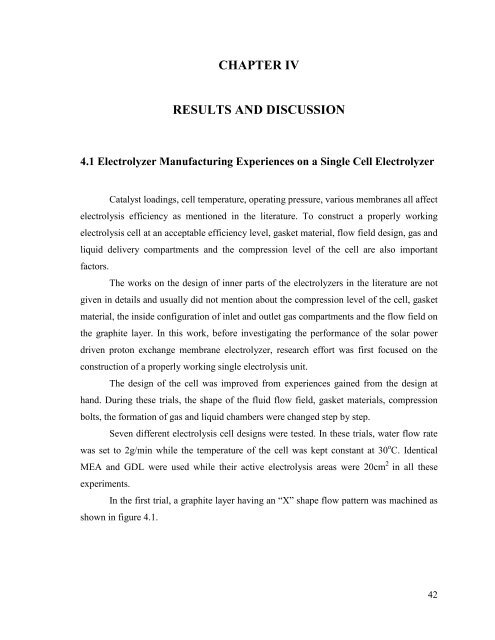hydrogen production from water using solar cells powered nafion ...
hydrogen production from water using solar cells powered nafion ...
hydrogen production from water using solar cells powered nafion ...
You also want an ePaper? Increase the reach of your titles
YUMPU automatically turns print PDFs into web optimized ePapers that Google loves.
CHAPTER IV<br />
RESULTS AND DISCUSSION<br />
4.1 Electrolyzer Manufacturing Experiences on a Single Cell Electrolyzer<br />
Catalyst loadings, cell temperature, operating pressure, various membranes all affect<br />
electrolysis efficiency as mentioned in the literature. To construct a properly working<br />
electrolysis cell at an acceptable efficiency level, gasket material, flow field design, gas and<br />
liquid delivery compartments and the compression level of the cell are also important<br />
factors.<br />
The works on the design of inner parts of the electrolyzers in the literature are not<br />
given in details and usually did not mention about the compression level of the cell, gasket<br />
material, the inside configuration of inlet and outlet gas compartments and the flow field on<br />
the graphite layer. In this work, before investigating the performance of the <strong>solar</strong> power<br />
driven proton exchange membrane electrolyzer, research effort was first focused on the<br />
construction of a properly working single electrolysis unit.<br />
The design of the cell was improved <strong>from</strong> experiences gained <strong>from</strong> the design at<br />
hand. During these trials, the shape of the fluid flow field, gasket materials, compression<br />
bolts, the formation of gas and liquid chambers were changed step by step.<br />
Seven different electrolysis cell designs were tested. In these trials, <strong>water</strong> flow rate<br />
was set to 2g/min while the temperature of the cell was kept constant at 30 o C. Identical<br />
MEA and GDL were used while their active electrolysis areas were 20cm 2 in all these<br />
experiments.<br />
In the first trial, a graphite layer having an “X” shape flow pattern was machined as<br />
shown in figure 4.1.<br />
42

















